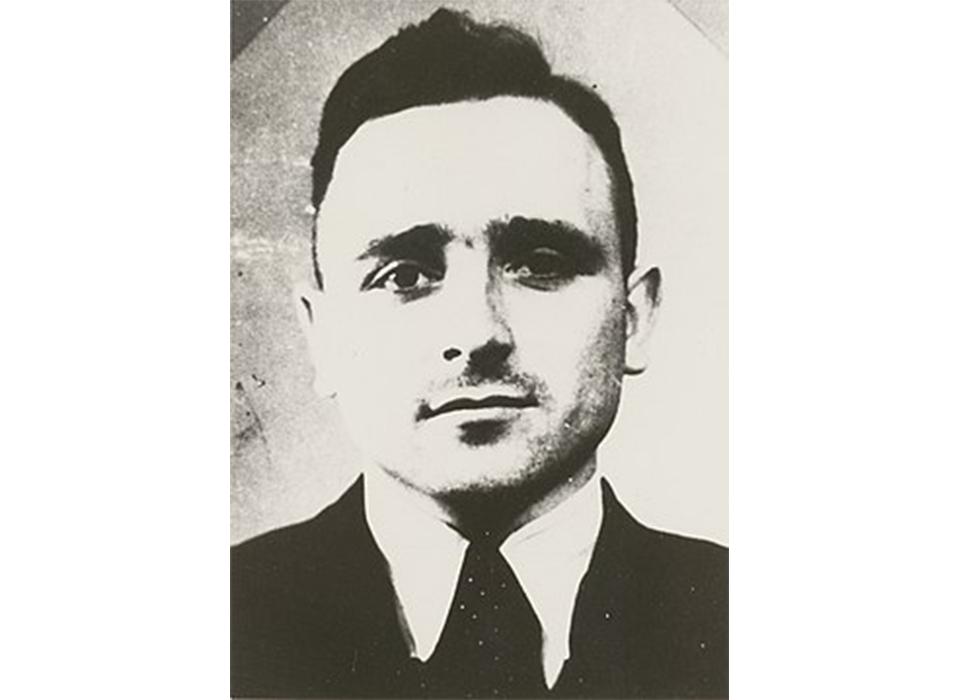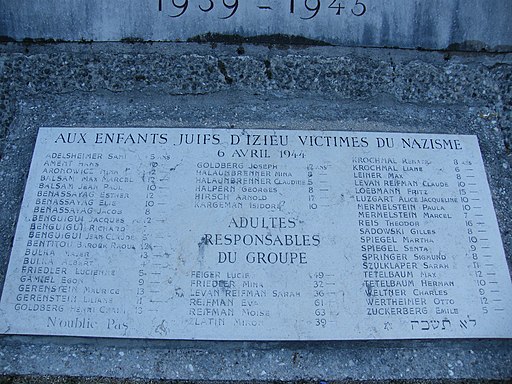Top Header Source: Archives du department du Rhône et de la métropole de Lyon. Retrieved from Wikimedia Commons.
The destructiveness of modern industrial warfare does not spare a society’s most vulnerable. Missiles, bombs, artillery shells, and mines kill children, the mentally and physically disabled, the very ill, and the elderly just as they do those human beings deemed justifiably killable during wartime. When these defenseless individuals perish, whether accidental or not, it is horrendous. When there is no question of a mistake or of an unavoidable combat situation, when men and women deliberately and systematically target the ill-protected, we can only classify the perpetrators as truly inhuman monsters.
The Third Reich’s terror apparatus teemed with such inhumanity. Adolf Hitler, Heinrich Himmler, Reinhard Heydrich, Hermann Goering, Ernst Kaltenbrunner, Martin Bormann, and Joseph Goebbels knew perfectly well that they could rely on an array of mostly younger, fanatical Nazis to carry out their genocidal annihilation policies against the disabled, against Jews, and against Roma and Sinti. As Wendy Lower’s Hitler’s Furies shows, sometimes the fanatics were women. Mainly, though, they were young, talented, well-educated, and fervently ideological men from Germany and Austria who staffed the Schutzstaffel (SS), the Sicherheitsdienst (SD, the intelligence-gathering branch of the SS), and the Gestapo. During World War II, this cohort of dedicated and vicious Nazis fanned out across German-occupied Europe, enforcing Hitler’s reprehensible vision of the racial restructuring of the continent. The crimes they committed in their Führer’s name still scar European and world history and memory.
As we near the anniversary of D-Day, the atrocities carried out by Gestapo official Nikolaus “Klaus” Barbie (1913-1991) in France prior to the Allied liberation of the country is the subject of this piece. Barbie, later named the “Butcher of Lyon,” tortured, murdered, and deported thousands of resistance fighters and Jews during his time in France.
Writing about him brings back many personal memories. Asked recently by the organization L’Union Française and by faculty at the Academy of the Sacred Heart in New Orleans to give lectures on Barbie, the city of Lyon, and the French Resistance, quite a few things came back to me. More than three decades later, I still vividly remember Barbie’s extradition from Bolivia to France in 1983. The publicity surrounding his trial in the city of Lyon, where he perpetrated so many of his crimes, was massive. I was too young, though, to really grasp the enormity of what Barbie did, the ferocity of discussions within France about the extent of collaboration with the Germans, or the role of the American Counter Intelligence Corps (CIC) in getting Barbie out of Europe to a new haven in South America. Serious understanding of those issues only came years afterwards.
In a long list of unspeakable acts, Barbie’s operation in April 1944 against a group of children stands out. In the remote locale of Izieu, France, Barbie, never known for moral scruples or mercy, crossed a final threshold of criminality.
Before this mission, Barbie had already achieved fame within the ranks of the Gestapo. After his dreams of becoming a priest fell apart, Himmler’s SS accepted him into its ranks in 1935 when he was just 22. Soon Barbie joined the SD, quickly demonstrating his aptitude with interrogation methods. This knowledge proved terrifyingly effective once World War II began. As anti-Nazi resistance movements emerged in western Europe after German victories there, the SS assigned him to Amsterdam. Barbie participated in the crushing of the Amsterdam General Strike in February 1941. Impressing his superiors, he transferred to France where he worked for the Gestapo, the notorious Nazi secret state police. After a stint in Dijon, Barbie relocated to Lyon, a center for partisan activity.
In Lyon, Barbie succeeded in arresting Jean Moulin, a crucial figure in the French underground. Thanks to Moulin’s diligence and talents as an organizer, the many, often radically opposed tendencies in the resistance had coalesced around the leadership of Charles de Gaulle in the spring of 1943. With the help of informers, Barbie rounded up Moulin and several others the following June. Despite enduring horrific torture, Moulin evidently never gave up names. He died from the effects of the interrogation in July en route to Germany.
Moulin was one of thousands of resistance fighters who perished while Barbie served as Gestapo chief in Lyon. Marcel Ophüls’s powerful documentary film, Hôtel Terminus: The Life and Times of Klaus Barbie, released shortly after the conclusion of the Barbie Trial, captures several of their stories. Women and men went through this hell on the second floor of Lyon’s aptly named Hôtel Terminus. With his subordinates Harry Steingritt and Karl-Heinz Müller, Barbie showed himself to be a master torturer, a sadist who truly relished dispensing pain and humiliation. Rubber truncheons, clubs, and chair legs were choice instruments to supplement the simple punch or kick. He also alternated other techniques: ice baths, boiling water, and hanging the victim upside down.
At Izieu, Barbie did not have to use such sickening violence. A small village about 45 miles from Lyon that looked out over the Rhône River Valley, the Izieu community possessed a tremendous secret: 44 Jewish refugee children. They had been moved there in May 1943 by the Oeuvre de Secours aux Enfants (Children’s Aid Society), or OSE, a Jewish organization committed to child welfare. The children came from across Europe—from France, Germany, Austria, and Belgium. Several of them had found their way in previous years across the Mediterranean from the French colony of Algeria. Ages varied from as young as four to as old as 17. Hidden from the Nazis in a farmhouse with the knowledge of officials in Izieu, this children’s home owed everything to the efforts of the “Dame d’Izieu” (Lady of Izieu), Sabine Zlatin, herself from a Polish Jewish family. With her husband, Miron Zlatin, she directed and protected its affairs.
How did Barbie and the Gestapo ever discover them? An informer. Someone passed information to him about these children.
Early on April 6, 1944, Barbie’s team raided the farmhouse. The group was enjoying breakfast when the Gestapo arrived. The Nazis swept up the 44 children and seven of their adult protectors. One adult managed to elude them. It was a stellar moment for Barbie who gleefully reported to his superiors that he had uncovered a “children’s colony.” He did not delay in taking the next obligatory steps.
Afraid that local authorities might hinder the removal of these refugees, Barbie arranged for their immediate transportation to the transit camp at Drancy. The Izieu children shared the fate of more than 70,000 who entered and departed this camp in a northeastern suburb of Paris. In three different transports that left Drancy in April, May, and June 1944, they were sent to Auschwitz-Birkenau. Following a terrible journey in cattle cars, these children met an abhorrent end. The SS marched them into the gas chambers immediately after their arrival. Nazi officials deported Miron Zlatin separately. He was eventually shot in Estonia with two of the oldest children. Even then as an Allied invasion of France loomed, Barbie felt proud of his role in dealing with more of the Reich’s “enemies.”
The heinous actions of Barbie must be considered, however, within a larger, genocidal context. As Saul Friedländer expressed it so forcefully, “the murder of the children and staff of Izieu was but a minute event in the routine of German mass extermination, but it demonstrated, as the war entered its last year, that despite the rapidly deteriorating situation of the Reich, no effort would be spared, no roundup deemed too insignificant in the final drive toward the complete extermination of the European Jews.” The men who landed on D-Day and those who reinforced them afterwards would make their own discoveries of thousands of Nazi atrocities which dotted the European continent.
Sheer luck saved Sabine Zlatin. Three days before Barbie’s raid, she had journeyed to Montpellier to pin down a new haven for the children. Subsequently, she learned that everything and almost everyone she had labored to protect in Izieu had fallen into the hands of the Gestapo.
Zlatin’s accidental survival in April 1944 meant that, decades later, she could give damning testimony against a remorseless Barbie during his trial. In the proceedings, she recalled the lives of the children’s home—and its liquidation. What she said was unforgettable for those in attendance in Lyon.
Condemned by the court to life imprisonment for crimes against humanity, Barbie did finally pay for what he did at Izieu. The “Butcher of Lyon” died of cancer in a French prison in September 1991 at the age of 77.
Jason Dawsey, PhD
Jason Dawsey, PhD, is ASU WWII Studies Consultant in the Jenny Craig Institute for the Study of War and Democracy.
Cite this article:
MLA Citation:
APA Citation:
Chicago Style Citation:







![Max Fuchs, New York City cantor, sings as Rabbi Sydney [sic] Lefkowitz, Richmond, VA, conducts the first Jewish services from Germany.](/sites/default/files/styles/max_650x650/public/2025-10/image1.jpg)



